15 SEO Trends To Look Out For In 2023
If you thought the SEO competition was fierce in 2022, 2023 is going to be a whole new ball game.
Google has a knack for changing the SEO landscape faster than Usain Bolt finishes a 100-meter sprint. Blink once, and you’ll see significant changes that affect search engine visibility, crawling, indexing, and ranking.
As we get closer to ringing in the New Year, we can’t help but wonder what Google has up its sleeve—and some of the tricks have already started revealing themselves!
In this blog, we’ll take a closer look at some SEO trends this year. If you want to rank higher on Google SERPs, it’s time to master these trends and sneak a spot into Google’s good books. We’re here to help you do just that.
Top SEO Trends for 2023
1. Core Web Vitals
In 2023, up-and-coming businesses can’t afford to ignore Core Web Vitals.
Google keeps emphasizing the importance of user experience for a reason. Web users aren’t just chasing quality products and services anymore; they also want a kickass user experience.
So what are Core Web Vitals? They’re a set of specific factors that measure and evaluate user experience, and apply to all webpages. Is your website speedy, responsive, and visually stable? After analyzing your site and answering these questions, Google will award you a ranking spot accordingly.
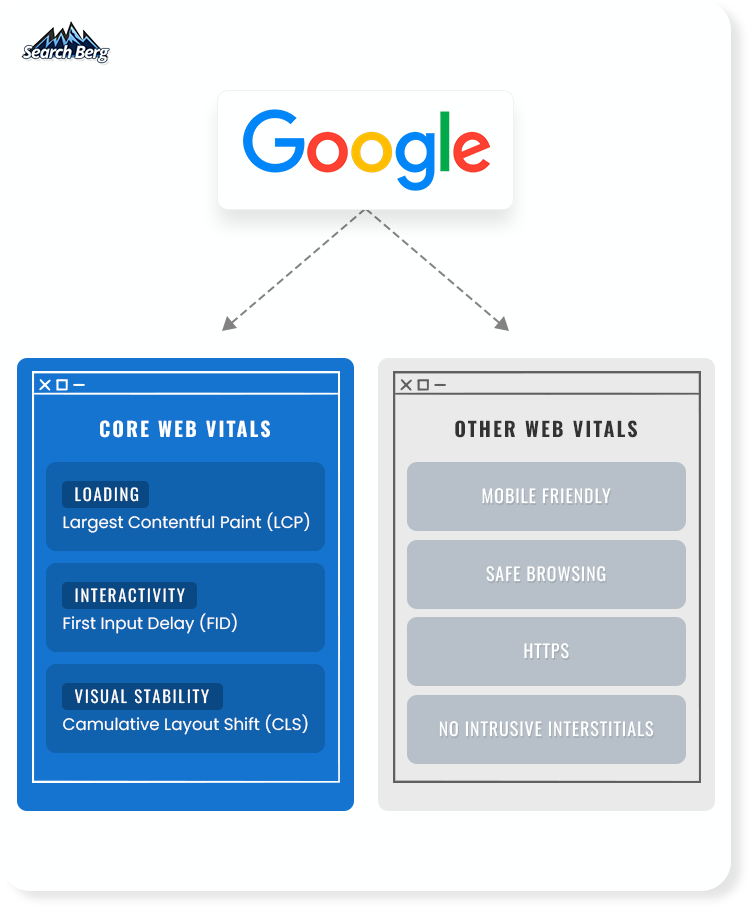
If you’ve been ignoring Core Web Vitals in 2022, it’s time to make some changes in 2023. These metrics have already been under the limelight, but they’re expected to become an even bigger focus in 2023. The goal is to provide a fast, interactive, and visually stable user experience.
Here are the Core Web Vitals all laid out:
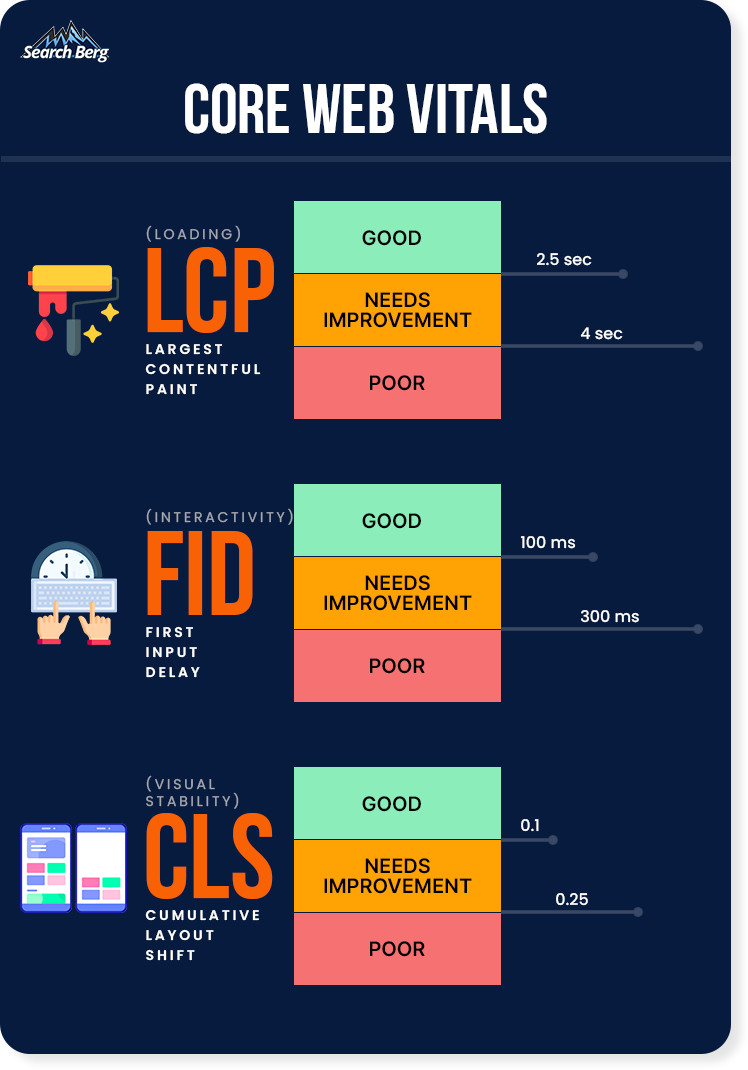
1.1 Largest Contentful Paint (LCP)
LCP determines the render time of the largest blocks visible to your audience. It’s the time taken for most of the on-screen content to become visible to web users.
What content are we talking about? Images, background images, video poster images, and block-level text. Your job is to create a fast, enjoyable, and seamless user experience. Speed things up, and your rankings will start shaping up.
Aim for an LCP that’s 2.5 seconds or lower.
1.2 First Input Delay (FID)
FID assesses a page’s responsiveness. Can users interact with your page easily? An interaction is any action taken on your site. If a user selects an option from the menu, clicks on a link, or enters their email into a field, they’re interacting with your page.
FID determines how quickly your webpage responds to a user’s input (click, key press, etc.). Aim for an FID below 100 milliseconds.
1.3 Cumulative Layout Shift (CLS)
CLS measures how visually stable a page is as it loads.
What do we mean by this? If elements move around your page as it loads, you have a high CLS. This is bad news. The goal is to make page elements as stable as possible. If text, banners, and buttons move around, web users may end up clicking on something else by mistake.
Let’s say a web user wants to add an item to their cart. If on-screen elements shift and they accidentally end up clicking on the checkout tab, they’ll be less than pleased. These little mess-ups are very common, and they ruin the user experience. Try to maintain a CLS of 0.1 or less.
2. Passage Ranking and Keyword Ranking
On February 10th, 2021, Google launched the passage ranking update that sent ripples across the SEO industry. Every time Google launches an update, marketers spring into action. This update had a similar impact but slightly subtler.
Why? Marketers started comparing passage ranking with keyword ranking and argued that the latter was more powerful and significant. In 2023, it’s time for a reality check. Let’s cover the basics before we dive deeper.
According to Google, passage ranking is an efficient ranking system that determines the relevance of web content by analyzing individual passages. If you searched for “how to change a tire” before this update, Google would’ve fetched a bunch of articles and blogs.
After passage ranking, web users receive results that answer their questions as accurately as possible.
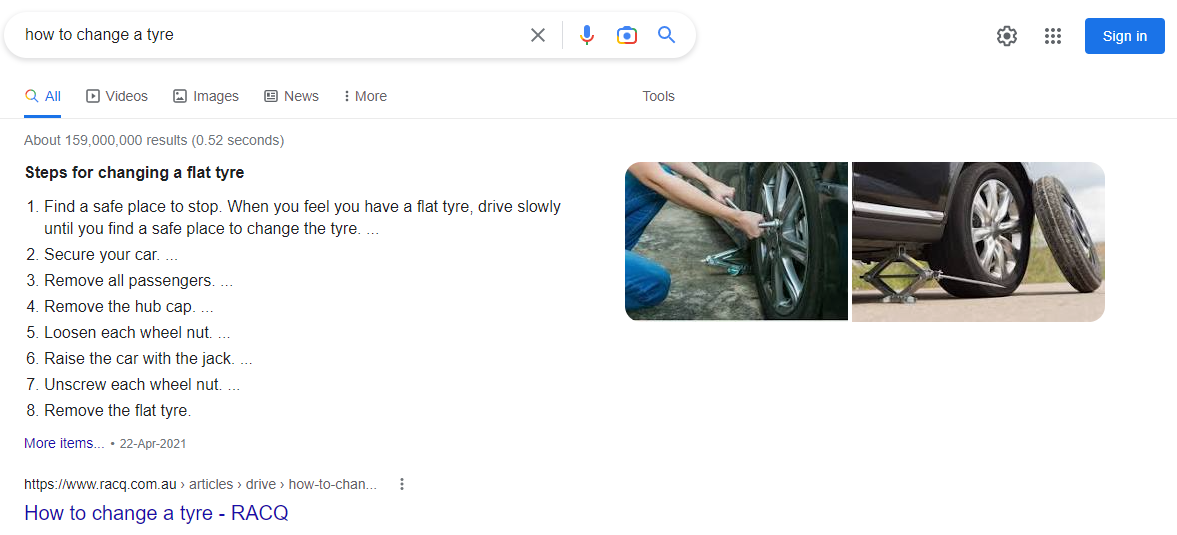
Succinct and direct, this section tells you exactly what you need to know. There’s no fluff or beating around the bush.
The outcome? A speedier search experience! You don’t have to explore a bunch of sites; the first one precisely addresses your concerns. Here’s what Google has to say:
“By understanding passages in addition to the relevancy of the overall page, we can find that needle-in-a-haystack information you’re looking for.”
Let’s circle back to the tussle between keyword ranking and passage ranking. Since both of these were prominent ranking systems, they were immediately juxtaposed. But this comparison is unjustified; both keywords and context are equally important.
The entirety of 2021 and 2022 were spent determining which ranking system takes precedence over the other. In 2023, it’s time to break the fight and start leveraging both systems. Passage ranking is extremely important, but this doesn’t mean that keywords are taking a back seat. If you want to rank higher on Google SERPs, master the art of using relevant keywords with high search volume and make context a priority.
You already know how the keyword game works. If you want a quick refresher, explore this guide. Start prioritizing context and relevance as well. Write focused, unique, high-quality, and value-added content that answers the question at hand as succinctly and accurately as possible.
Your subheadings should serve as a map. When written in list form, they should serve as a basic standalone guide. Google doesn’t always present content with subheadings. If you search for “what’s a cash advance,” the top search result will look something like this:
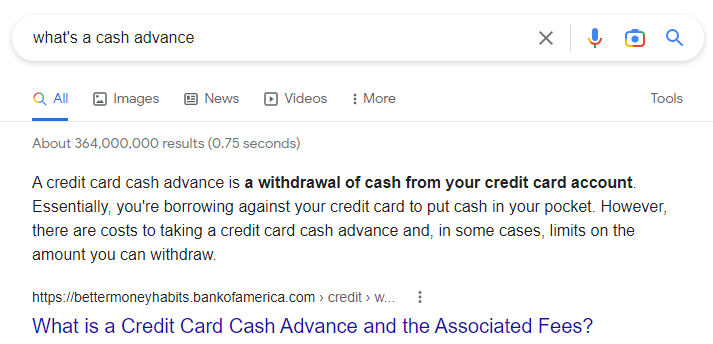
Why did they select this content?
Because it answers the question accurately, with no fluff. The first sentence offers a standard definition. This is followed by a two-and-a-half sentence-long simplification.
Write meaningful, intentional content that gives web users what they want. You still have room to be creative. However, the title should be answered within a short paragraph or through subheadings. When you combine this technique with a robust keyword plan, you’re looking at impressive rankings!
3. Multimodal Machine Learning
Google is known for switching things up every now and then, but that’s not all. How we find information online has also changed significantly over the past two decades.
Let’s hop onto an imaginary time machine and transpose ourselves to 2002. If you wanted to download Harry Potter and the Chamber of Secrets, you may have found yourself searching for “harry potter and the chamber of secrets download free full version” on Yahoo or Ask Jeeves.
Quite a mouthful, right?
In most cases, the results wouldn’t have been relevant, even though you laid pretty much everything out. Fast forward to 2022, and you can casually toss out search requests on your smartphone, smartwatch, or smart speaker and receive a set of hyper-specific results. 2023 will follow the same trajectory—and it’s all thanks to machine learning and artificial intelligence (AI).
Google’s 2019 BERT AI update was considered their most significant update in five years, and with good reason. To put it very simply, it helps machines understand the context of words in a sentence (even if the context isn’t actually provided).
Google topped the game by releasing an even more advanced version of this technology, namely, the Multitask Unified Model (MUM). Now, this is genius. Why? Because it’s multi-modal, i.e., it understands information across text, images, audio, and video (multiple modalities). It’s 1,000 times more efficient than BERT. In fact, it has the superhuman ability to speak 75 languages.
Where are we going with this?
In a nutshell, text isn’t the be-all and end-all of search. As search engines become smarter, multimedia and multilingual content are rising to the top. This doesn’t mean that written content isn’t relevant anymore. It simply means supplementing your content with multimedia is the move to make.
If you want to improve your organic search rankings in 2023, there’s no way you can rely on standalone text. Not a chance. Your content should be rich, exciting, visually stimulating, and aesthetically appealing.
Keep balance in mind; don’t go overboard. Incorporate images, videos, infographics, concept illustrations, GIFs, and other types of media into your content in moderation. This will go a long way in boosting your rankings.
When you search for “how to bake a hazelnut cake,” Google fetches these search results:
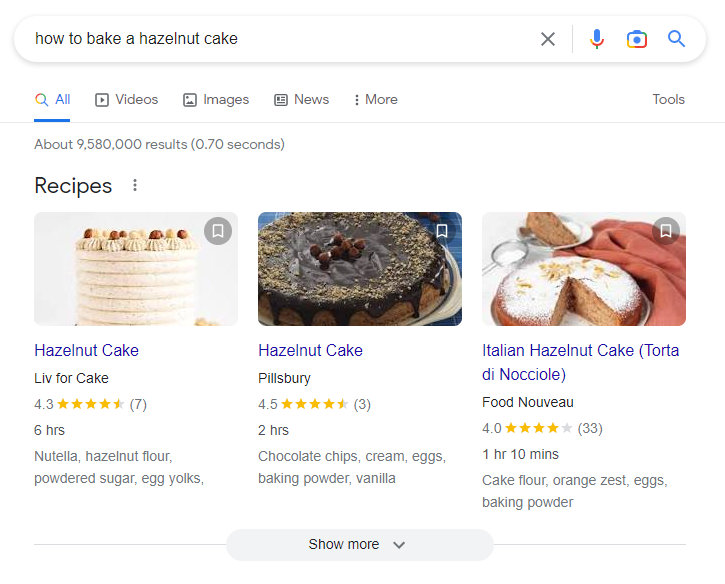
Notice something?
All three images are beautifully shot, no qualms about it. If the content didn’t feature pictures, it wouldn’t have been ranked in this snippet. And if the pictures were low-quality, Google’s picky algorithm may have had Cher’s “ugh, as if” moment.
Start incorporating high-quality, relevant, and eye-catching media into your content. Whether you’re working on your home page, writing a blog, or creating a listicle, keep it multimedia-heavy (not too heavy) to boost your rankings and reel in a wider audience.
4. Clip & Seek Markup
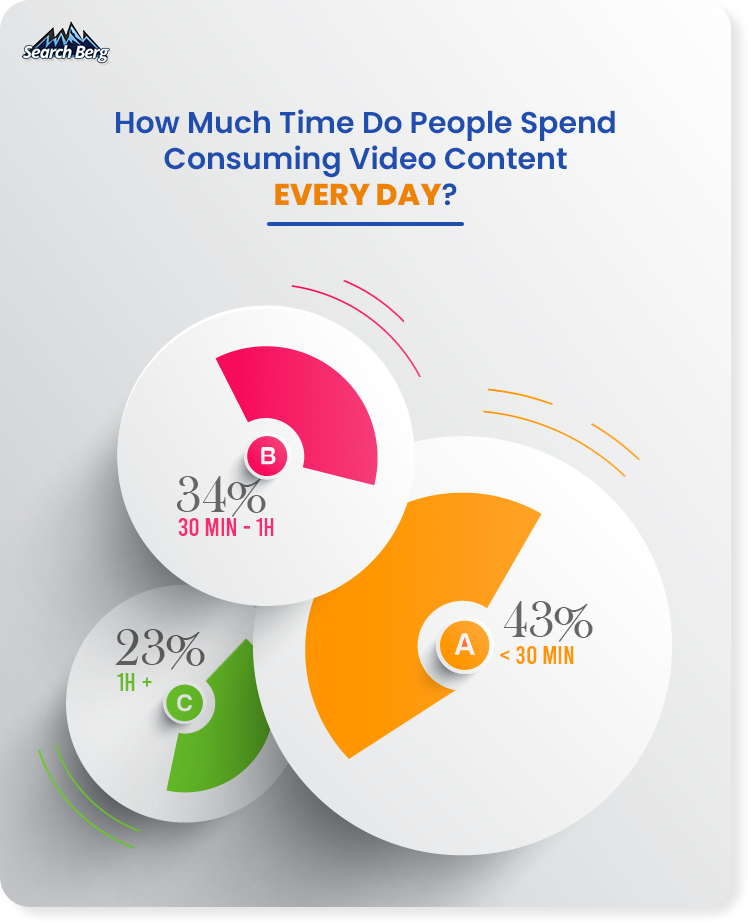
Video content is powerful. And it’s getting more and more and more popular every day! We already know Google isn’t one to stay quiet in a corner of the room. Active and alert, Google ups its game as rigorously and frequently as it can.
Google’s clip and seek markup is exciting stuff for brands that create video content (and if you haven’t already jumped on that bandwagon, it’s about time). Both clip and seek are types of schema markup.
Clip markup tells Google about the specific segments (clips) in video content. Seek markup utilizes the power of machine learning to automatically create relevant key moments in video content.
Here’s an example:
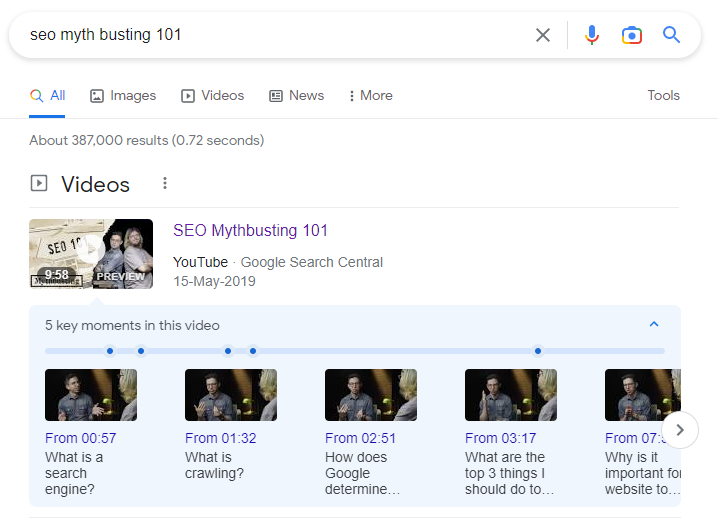
So what do you need to do? It’s simple. Tell Google exactly which timestamps should be presented as key moments. You’ll have to follow a set of guidelines. Once you get this sorted, your videos stand out from the rest.
People want ease and convenience. When they can see exactly which moments you talk about and when, they’re more likely to click on the video (even if it’s long). As you simplify user experience, your ranking abilities will improve. You’re helping web users save time and get hyper-specific information. It’s a win-win; your audience gets the information it needs, and you get a generous boost in rankings!
Recommended Read: How to Promote Your YouTube Channel: The Only Guide You Need
5. Featured Snippets
We’ve touched upon featured snippets above, but it’s time to take a deeper dive into this genius feature. SERPs have evolved drastically over the years. In 2023, we expect Google to drop some cool new snippets. Until then, it’s time to make full use of the snippets that we already know about!
Google has a razor-sharp focus on simplifying and enhancing user experience.
- How can web users get relevant information in the shortest amount of time?
- How can they have a visually appealing experience?
- How can they get an accurate overview of the content they’re about to explore?
As Google works on these questions and fine-tunes user experience, the search and browsing experience has become as robust and seamless as possible—and it’s about to get even better! Make sure you leverage featured snippets to show Google that you’re doing exactly what it wants you to do: simplify user experience! So what are featured snippets?
According to Google, “Featured snippets are special boxes where the format of a regular search result is reversed, showing the descriptive snippet first.” Think of them as customized search results that answer search queries with audience requirements in mind.
There are many, many different types of snippets. Let’s take a closer look at some of them:
5.1. Definition Snippet
![]()
5.2. Image Snippet
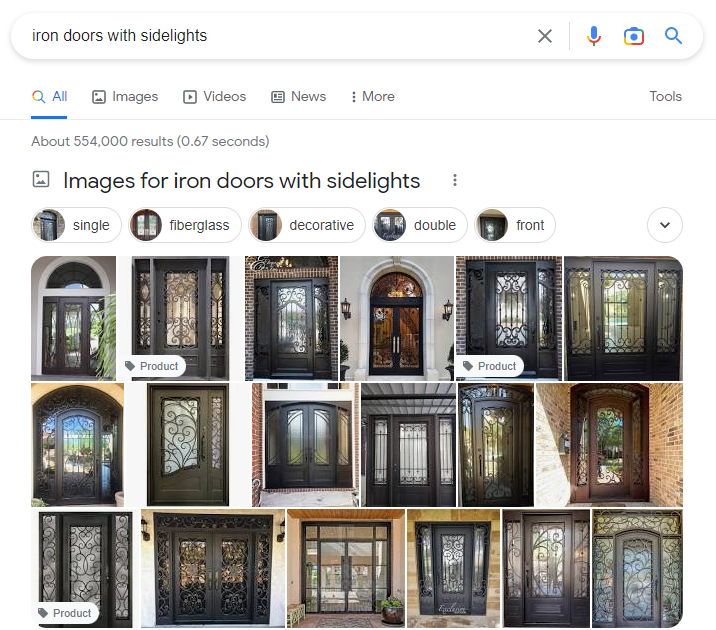
5.3. Listicle Snippet
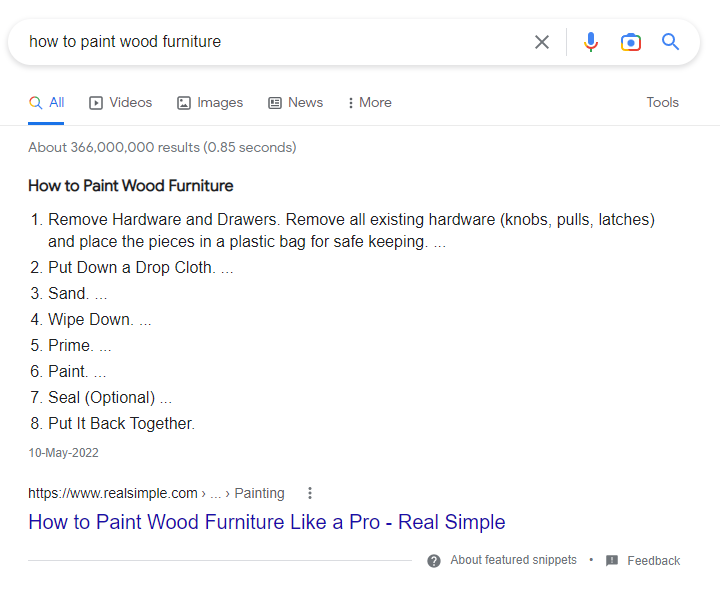
5.4. Table Snippet
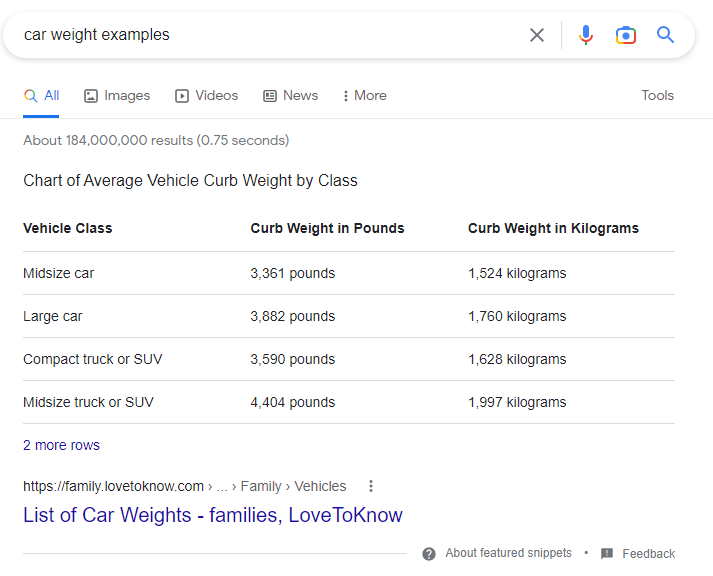
5.5. Video Snippet
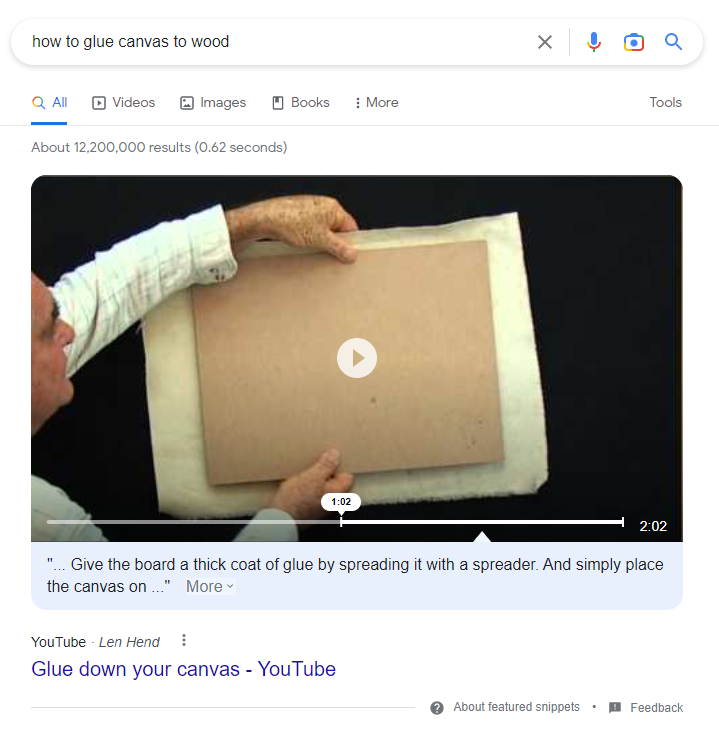
5.6. Recipes Snippet
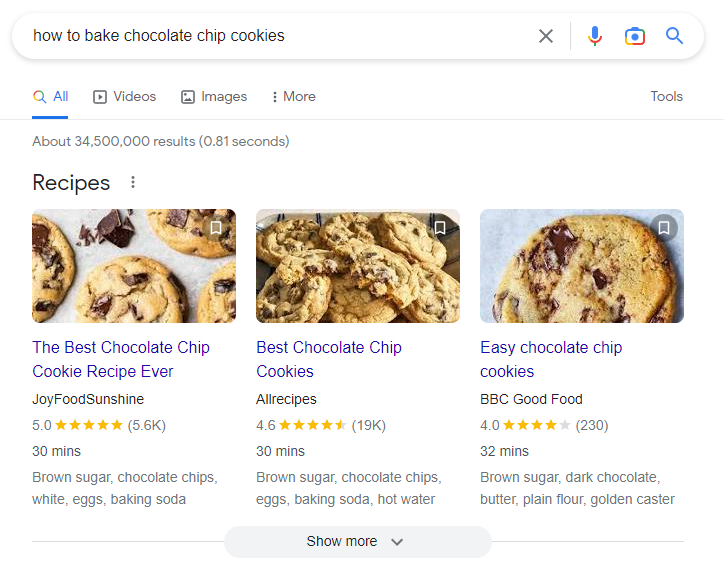
If you want your rankings to shape up, start aiming for the most relevant snippets for your industry.
- If you’re a baker, shoot for the recipes snippet
- If you create tech videos on YouTube, try to be featured in the video snippet
- If you sell iron doors, you should strive for the image snippet
Every snippet has its own optimization requirements. Master these, and you’ll get your rankings back on track in 2023.
6. User Intent Metrics
Even if you’ve previously ignored user intent metrics, you can’t afford to keep overlooking them this year. Understanding user intent is pivotal. Your audience may have navigational intent (trying to find a certain site), informational intent (trying to find information and knowledge), commercial intent (trying to guide a buyer), or transactional intent (trying to make a transaction, i.e., purchase a product, subscribe to a service, etc.).
Users will exhibit unique behavior on your website based on their intention. If you want to keep your visibility, organic traffic, rankings, and conversions on growth, start looking at the most critical user intent metrics:
6.1. Bounce Rate
How many web users are visiting your site and immediately leaving without any interaction? If your site has a high bounce rate, you’re doing something wrong. Ultimately, your page isn’t satisfying user intent. Maybe the web design is off-putting. Perhaps your site is too slow. Or the web copy may be boring.
Understand what’s going wrong and correct it ASAP. You may have to run a website audit.
6.2. User Retention
How many web users are you retaining? When a visitor buys a product or subscribes to your services, are they returning?
If they’re leaving, you’re not providing good value. Google reviews are a prominent ranking factor. If people don’t like your products/services, they’ll leave bad reviews. Over time, this will affect your rankings.
We recommend emailing a “What Went Wrong?” form to customers who never returned. Try to get their feedback and implement it. User retention is extremely important for consistent revenue generation. Undo the damage to get back on track. As your reviews improve, your rankings will get a significant boost.
6.3. Behavior Flow
Google Analytics helps you track this metric. When a web user visits your site, which page is their entry point? What do they click on, and which pages do they explore?
By understanding user behavior, you’ll be able to visualize the path users follow to explore your website. This information will help you determine the most engaging web content or webpages.
Are certain blogs getting more attention than the others? Is the video on your homepage getting ample clicks? Are there certain pages/multimedia that aren’t getting enough attention? Use this information to rework your website.
7. Freshness
As a query-dependent ranking factor, freshness is set to become even more important in 2023. Let’s understand what this means. Not every query on Google is “fresh”, i.e., time-sensitive. For example, if someone searches for “the best way to learn French,” they’ll receive a set of potentially old search results. Will that matter? No, because this query is not time-sensitive.
However, if someone searches for “new true crime documentaries,” the search results will be new/fresh because this is a time-sensitive search. In 2023, fresh content is expected to increase in demand. As new trends, topics, events, pop culture moments, and conversations enter the fold, web users want hyper-relevant content.
Start brainstorming time-sensitive content ideas that will improve your rankings for the time being. Of course, the content will become irrelevant at some point. When that happens, rework it like a pro.
For instance, if you write a blog titled “X Modern Steel Doors That Are All the Rage in 2022,” your content will become irrelevant this year. Change the title to “X Modern Steel Doors That Are All the Rage” and remove all references of 2022.
This is how you turn content that was fresh at some point into regular content that can still be consumed despite being outdated. Create fresh content around special occasions (Halloween, Christmas, New Year’s Eve, etc.), pop culture moments, events, trends, and so on.
This is a great way to strike while the iron’s hot. Once the iron cools down, you know what to do (rework away). Keep this practice!
Recommended Read: Real-Time SEO Content Writing: A 7-Step Process for Everyone
8. Mobile, Mobile, Mobile!
You’re probably tired of reading about the importance of launching a mobile-friendly website. No matter how many times this point is reiterated, it’ll never be enough. Smartphones are the future of online shopping. And this future is actually upon us!
As we kick off 2023, more and more web users are expected to shop using their phones. Computers, laptops, and tablets are taking a back seat. If your website isn’t mobile-friendly, you’re hurting your rankings. It’s as simple as that.
Start by running the mobile-friendly test to gauge where you stand. If you’re not on the right track, it’s time to rework your website. We also recommend launching a mobile application to reel in a wider audience.
Why?
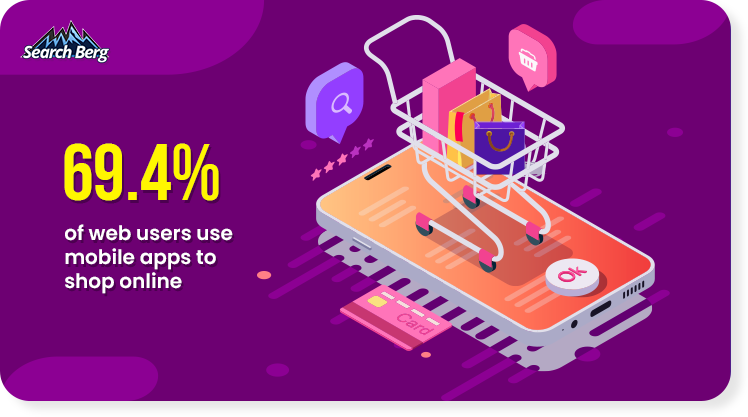
See what we mean?
Your mobile app should be available to both iOS and Android users. Prioritize security, user experience, performance, interactivity, seamless scrolling, speed, and simplicity.
Avoid skimping on app design and development. If your app works flawlessly but lacks aesthetic appeal, your audience will hit the “uninstall” button before you know it. And if your app looks great but runs slowly or presents any other critical development problems, your audience will head towards the nearest exit.
Check all the boxes off the list. Once you get this right, you’re in for quite a ranking treat (yes, mobile-friendliness is a ranking factor).
9. The New E.E.A.T

Move over, E.A.T. In 2023, we’re following new search rater guidelines to make it to Google’s good books.
E.E.A.T stands for experience, expertise, authoritativeness, and trustworthiness. By adding an E for experience, Google wants creators to know that first-hand experience is a critical feature of quality content.
When content is created with a high degree of experience, both Google and web users are more likely to trust it. Let’s consider an example. If you’re interested in filling out your tax returns, you’ll try to find content produced by an accounting expert. However, if you’re curious about how effective and accurate a certain tax preparation software is, you’ll feel more comfortable hearing from people who have used it before, perhaps members of a forum or social media users.
Experience adds an element of added helpfulness and reliability to content. It’s a way for web users to confirm that the advice provided is genuine and honest, not salesy and inauthentic.
If a content creator is an industry expert but lacks experience, chances are web users won’t feel comfortable taking their advice. When all five content characteristics are checked off the list—experience, expertise, authoritativeness, and expertise—Google labels such sources as highly credible, reliable, and trustworthy.
If you want to rank higher on Google SERPs in 2023, create content with high E-E-A-T. How can you do this? By incorporating authentic product reviews into your content and handing over YMYL topics to experienced industry experts.
If you’re writing a recipe, make sure you’ve tried it before. If you’re giving your two cents on a product/service, make sure you’ve used it before. If you’re offering advice on a sensitive topic, make sure you’ve experienced similar circumstances before.
It’s that simple. Hand over the content creation process to people who have been in the audience’s shoes. When a cancer survivor shares tips on how to get through chemotherapy, cancer patients will take their advice seriously.
The reliability factor will help you write content that strikes a chord with your audience and ranks higher on Google SERPs. People will trust you instead of thinking you’re just trying to sell another product.
10. Helpful Content

Google’s helpful content update was fully released on September 9, 2022. In 2023, its usefulness is starting to become more evident.
What is helpful content? Google explains that any type of content that provides an excellent user experience is considered helpful content. This update was developed to reward content that provides a satisfying user experience and weaken the performance of content that fails to provide real value to users.
Think of this as a hyper-smart differentiation tool. At the end of the day, Google wants web users to enjoy a swift, seamless, and valuable browsing experience. The goal is to provide the most relevant type of content in the least amount of time possible.
The helpful content update amplifies original, helpful, and valuable content written for people by people. It makes the research process simpler and faster for people. Here’s how the update works: the helpful content system generates a site-wide signal that helps identify low-quality content that provides little to no value to users. Unhelpful content is demarcated from helpful content, and rankings are decided accordingly.
The classification process is fully automated; Google uses a cutting-edge machine-learning model to rank content accurately based on helpfulness. The update picks up on different types of content across all languages globally.
Now, content creators and webmasters can benefit from this update if they start creating content with the purpose of informing and providing value to readers. Your primary goal shouldn’t be securing high rankings; that will happen automatically if you create meaningful content. Instead of writing content to chase rankings and traffic, write content to satisfy your audience’s requirements.
Google centers web users and wants content creators to do the same. Niche down, demonstrate industry expertise, write for your specific target audience, provide value, and satisfy user intent.
Once you’re done writing content, ask yourself whether it’s helpful or not. Would you read it if you were in your audience’s position? Or would you keep scrolling and look for something else?
When you answer this question honestly, you’ll be able to fine-tune your content until your response is a confident “yes”. Help web users, and Google will help you achieve the rankings you covet. It’s that simple.
11. AI Content

AI content has been the biggest trend of 2023 so far, and we doubt it’ll disappear from our sights any time soon.
Your friends, family, and co-workers may have excitedly told you about this cool new app that generates fresh, original, high-quality, and plagiarism-free content on its own. No hard work needed from your end. It’s like adding ingredients to a big, shiny machine and watching a gourmet dish slide out, steaming hot and ready to eat.
Exciting? Yes.
Realistic? Well…not so much.
AI content generators like Jasper, Closers Copy, Writesonic, Rytr, Kafkai, Contentbot, and NeuroFlash promise to transform existing content on the web into value-added, original, and seamlessly woven content that cannot be red-flagged by modern algorithms.
Is this actually possible? Temporarily, yes. In the long run, no.
Before we explain why, let’s break down Google’s stance on AI content. Google has made it very clear that it has absolutely no problem with AI content. Danny Sullivan, Google’s Search Liaison, tweeted this in response to the buzz around AI content:
We haven’t said AI content is bad. We’ve said, pretty clearly, content written primarily for search engines rather than humans is the issue. That’s what we’re focused on. If someone fires up 100 humans to write content just to rank, or fires up a spinner, or a AI, same issue…
— Danny Sullivan (@dannysullivan) November 7, 2022
Google doesn’t really care what you do as long as you’re creating content for humans. Now, here’s the dilemma. AI-generated content is not created for humans. There’s no way it can provide the same value human-written content has to offer.
The level of research, deliberation, thought, expertise, experience, industry insight, and human judgment that goes into human-written content cannot be replicated by AI, no matter how advanced the technology may be.
At the end of the day, Google is keeping an eye out for content that fails to provide value. AI-generated content, by default, falls under the category of low-quality content. At some point, its lack of usefulness will be detected, and you will get penalized.
So what kind of content is Google looking for? We shed light on this earlier, and Danny further confirms its usefulness:
We did talk about a focus on content *by people* for people in our post about improvements like the helpful content system. But the nuance is really that it’s unlikely some AI content is going to feel written by people without some degree of human review: https://t.co/uRiqh7ftDL
— Danny Sullivan (@dannysullivan) November 7, 2022
As we highlighted earlier, focus on providing value to users, not cutting corners. Google wants you to bring out your A game for web users, not take shortcuts and expect glossy rankings in return. When you put your audience first, you’ll get rewarded with the rankings you deserve. But if you’re too focused on trying gimmicks, your content won’t go far.
So if you’re an SEO trying to figure out how AI fits in with being successful or not on Google, you’re too focused on the tool not the content. Is the content you’re producing helpful, reliable and people-first in nature? That’s what we’re looking for: https://t.co/rIKwa9fs7R
— Danny Sullivan (@dannysullivan) November 7, 2022
Instead of blindly jumping on the AI content bandwagon, take some time to consider the long-term repercussions of this decision. When content is created intentionally and meaningfully by experts, it performs exceptionally well on search engines and resonates with the target audience. Prioritize quality, and Google will give you the visibility, rankings, and traffic you asked for.
12. Longer Indexing Times
Google’s search relations representative, John Mueller, was asked about the indexing time for new pages during an AskGooglebot video. After initially giving the classic “It depends” response, he started digging deeper into the anatomy of Google indexing.
According to Mueller, it can take several hours or even weeks for Google to index new or updated content. If there are any technical problems with the website or GoogleBot simply has too much on its hands, it may take much, much longer.
In 2023, this trend is expected to continue and cause a lot of impatience. Businesses want their content to start ranking ASAP, especially if they cross all the requirements off the list and provide impeccable quality.
Unfortunately, this is wishful thinking. There are currently billions of webpages on Google. Collectively, they’re worth over 100,000,000 gigabytes in size. Since Google indexes each web page instead of entire websites, the total number of webpages that need to be indexed is higher than we can ever fathom.
What does this call for? Patience. Your webpages will not be indexed right away, and that’s okay. Expect longer indexing times in the coming months as Google gets flooded with a plethora of new webpages. The delay shouldn’t demotivate you. Keep at it; if you create human-centric content, you have nothing to worry about. Your rankings will shape up.
13. High-DA Backlinks (Not Just Regular Backlinks)
Link building is considered one of the top SEO strategies, but the landscape is changing in 2023. Previously, link building was an optional SEO practice; businesses could still enjoy good digital marketing success without having a robust link building plan in place.
In 2023, link building isn’t optional anymore; it’s becoming indispensable. Google has indicated that it will not be crawling pages as frequently. If you want to generate new pathways to your website, you must collect high-DA (domain authority) backlinks.
Domain authority is a measure of how well a website ranks on Google SERPs. The score ranges from 0–100; the higher, the better. When high-DA websites give your brand a shoutout, you’ll redirect their audience towards your site.
What does this mean for you? A power-packed boost in visibility, traffic, rankings, and conversions. Instead of aiming for regular backlinks, build high-DA backlinks that actually benefit your business.
Backlink quality is more important than quantity. When the top players link to your site, you’ll enjoy greater credibility and trustworthiness. Turn your attention towards high-DA guest blogging, social media outreach, link reclamation, influencer marketing, local link building, and email outreach.
14. Optimizing for Visual Intent
Visual content is a game-changer. No matter how engaging and exciting written content may be, visual content will always catch people’s eyes first.
Let’s consider an example. If you search for “how to do more pull-ups” on Google, you’ll fetch a plethora of search results.
A big chunk of the search results will provide detailed explanations on how to improve your pull-up technique, prevent strain, build strength, and so on. But what will dominate SERPs? Visual content, specifically videos, that show you the best way to do more pull-ups.
Instructional videos, images, and illustrations are extremely powerful. They can swiftly walk people through any topic without requiring them to put in much effort.
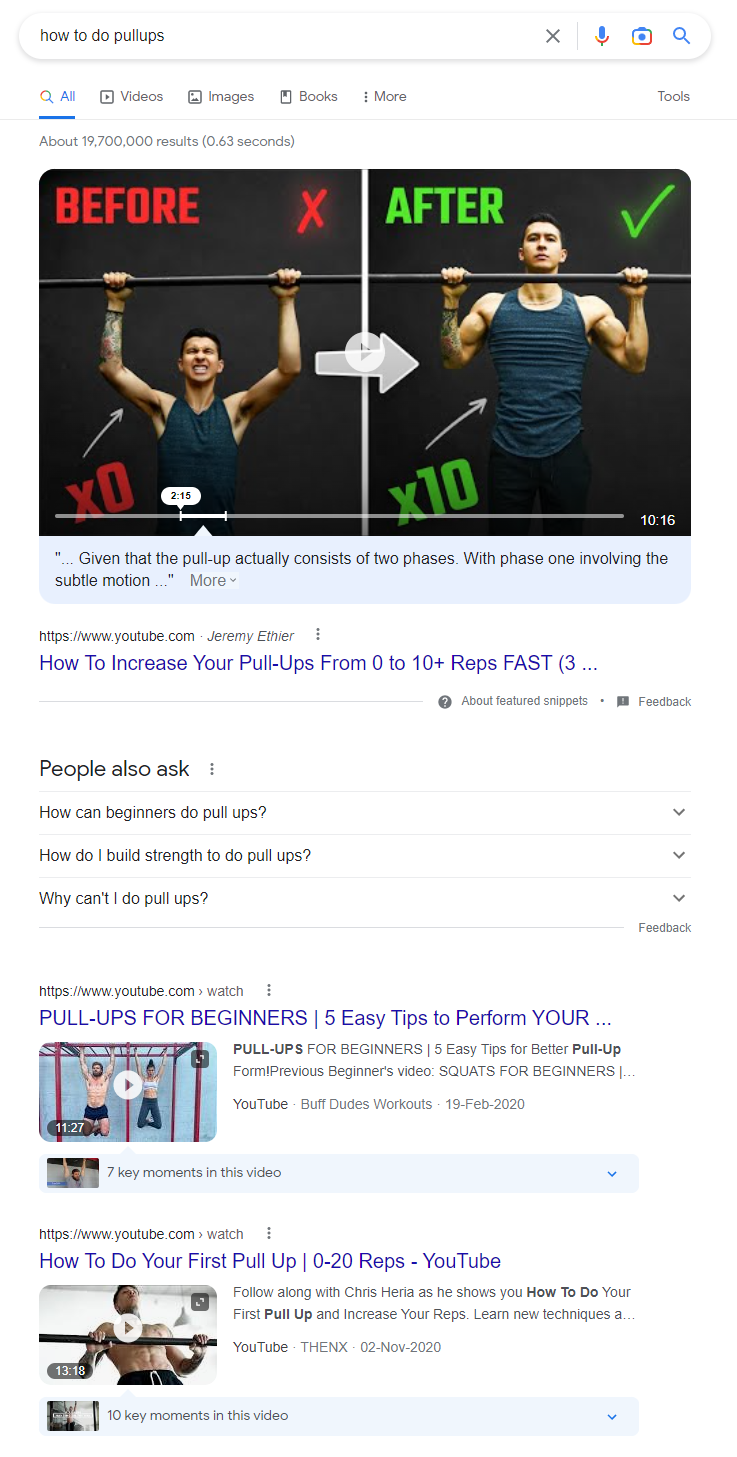
If you want to reel in a wider audience, start supplementing your content with high-quality media, including images, infographics, illustrations, GIFs, and videos. You’ll end up boosting audience engagement and improving your rankings like a seasoned pro.
It doesn’t end here. Make sure you optimize visual content to climb SERPs at a faster speed. Add image filename and alt text to images, select the right file format, compress and resize media, add keywords to media tags and descriptions, and periodically update the content.
15. Voice Search Optimization
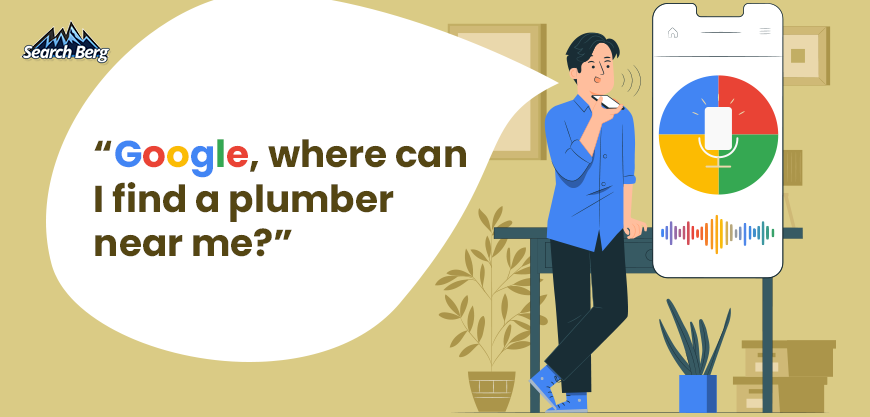
20% of all Google App searches are voice-based. If you want to improve your SERP rankings, optimize your website and mobile app for voice search.
In 2023, we’re expecting to see even greater voice search usage. As audio detection technology becomes more advanced, the risk of misheard audio commands is decreasing. This is compelling people to ditch text-based commands and switch to voice search for the large majority of search queries, if not completely.
Optimize your content for voice search by focusing on long-tail keywords with “near me” search terms. Your content should include a lot of natural, conversational language, i.e., phrases that people would say out loud.
We also recommend adding more local keywords to your content. Many web users give local voice commands, e.g., “where can I find Chinese food in Los Angeles?” If your content is locally optimized, it’ll rank higher for local search queries.
If you don’t already know about schema markup, get acquainted with it. Using schema to mark up your content is a great way to help search engines understand the context of your content. The outcome? You’ll rank higher for regular search queries and voice commands.
Climb the SERP Ladder with Search Berg!
Stuck with bad rankings? It happens. The competition is at an all-time high. As businesses consistently pull out their A game, you can easily get left behind. It’s time to change the game and bring out your A game. At Search Berg, we’re here to make it happen!
In this blog, we walked you through the top SEO trends for 2023. Let’s help you dominate SERPs, make better sales, and steer your business in the right direction.
Explore our professional SEO services to kick things off!












